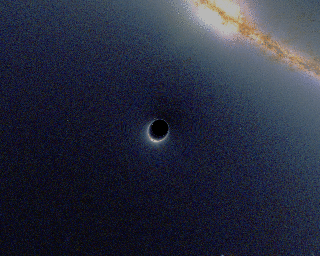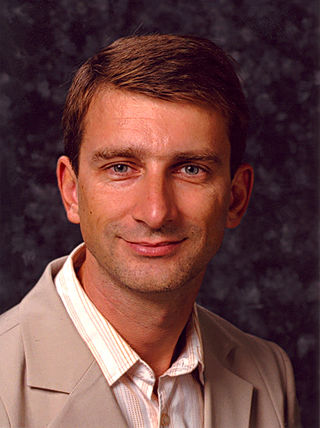The study of galaxy formation and evolution is concerned with the processes that formed a heterogeneous universe from a homogeneous beginning, the formation of the first galaxies, the way galaxies change over time, and the processes that have generated the variety of structures observed in nearby galaxies. Galaxy formation is hypothesized to occur from structure formation theories, as a result of tiny quantum fluctuations in the aftermath of the Big Bang. The simplest model in general agreement with observed phenomena is the Lambda-CDM model—that is, that clustering and merging allows galaxies to accumulate mass, determining both their shape and structure. Hydrodynamics simulation, which simulates both baryons and dark matter, is widely used to study galaxy formation and evolution.
Cosmic strings are hypothetical 1-dimensional topological defects which may have formed during a symmetry-breaking phase transition in the early universe when the topology of the vacuum manifold associated to this symmetry breaking was not simply connected. Their existence was first contemplated by the theoretical physicist Tom Kibble in the 1970s.

Willem de Sitter was a Dutch mathematician, physicist, and astronomer.

The Giant Metrewave Radio Telescope (GMRT), located near Narayangaon, Pune in India, is an array of thirty fully steerable parabolic radio telescopes of 45 metre diameter, observing at metre wavelengths. It is the largest and most sensitive radio telescope array in the world at low frequencies. It is operated by the National Centre for Radio Astrophysics (NCRA), a part of the Tata Institute of Fundamental Research, Mumbai. It was conceived and built under the direction of Late Prof. Govind Swarup during 1984 to 1996. It is an interferometric array with baselines of up to 25 kilometres (16 mi). It was recently upgraded with new receivers, after which it is also known as the upgraded Giant Metrewave Radio Telescope (uGMRT).
The Lambda-CDM, Lambda cold dark matter or ΛCDM model is a mathematical model of the Big Bang theory with three major components:
- a cosmological constant denoted by lambda (Λ) associated with dark energy,
- the postulated cold dark matter, and
- ordinary matter.

The Canada–France–Hawaii Telescope (CFHT) is located near the summit of Mauna Kea mountain on Hawaii's Big Island at an altitude of 4,204 meters, part of the Mauna Kea Observatory. Operational since 1979, the telescope is a Prime Focus/Cassegrain configuration with a usable aperture diameter of 3.58 metres (11.7 ft).
Guinevere Alice Mei-Ing Kauffmann was born in California. She is an astrophysicist and is known for her work studying galaxies among other subjects.

While the presence of any mass bends the path of light passing near it, this effect rarely produces the giant arcs and multiple images associated with strong gravitational lensing. Most lines of sight in the universe are thoroughly in the weak lensing regime, in which the deflection is impossible to detect in a single background source. However, even in these cases, the presence of the foreground mass can be detected, by way of a systematic alignment of background sources around the lensing mass. Weak gravitational lensing is thus an intrinsically statistical measurement, but it provides a way to measure the masses of astronomical objects without requiring assumptions about their composition or dynamical state.

Relativistic images are images of gravitational lensing which result due to light deflections by angles .

Uroš Seljak is a Slovenian cosmologist and a professor of astronomy and physics at University of California, Berkeley. He is particularly well-known for his research in cosmology and approximate Bayesian statistical methods.
Sarah Louise Bridle is a Professor of Food, Climate and Society at the University of York. She previously served as Professor of extragalactic astronomy and cosmology in the Department of Physics and Astronomy, University of Manchester where she applied statistical techniques to the cosmic microwave background (CMB) and on the use of weak gravitational lensing in cosmology. From 2006 - 2015 she co-led weak lensing efforts with the Dark Energy Survey (DES), was co-lead of the Euclid weak lensing working group and was Large Synoptic Survey Telescope (LSST) UK Project Scientist from 2013 to 2017.
Robert J. Nemiroff is an Astrophysicist and Professor of Physics at Michigan Technological University. He received his Ph.D. from the University of Pennsylvania in Astronomy and Astrophysics in 1987 and his B.S. from Lehigh University in Engineering Physics in 1982. He is an active researcher with interests that include gamma-ray bursts, gravitational lensing, and cosmology, and is the cofounder and coeditor of Astronomy Picture of the Day (APOD), the home page of which receives over a million hits a day, approximately 20% of nasa.gov traffic. He is married and has one daughter.
Andrew Collier Cameron is a British astronomer specialising in the discovery and characterisation of exoplanets. He is a founding co-investigator of the WASP project and served as the head of the School of Physics and Astronomy of the University of St Andrews between 2012 and 2015 where he is currently a professor.
The KBC Void is an immense, comparatively empty region of space, named after astronomers Ryan Keenan, Amy Barger, and Lennox Cowie, who studied it in 2013. The existence of a local underdensity has been the subject of many pieces of literature and research articles.

Alan R. Duffy is a British and Australian professional astronomer and science communicator. He was born in England, raised in Northern Ireland, and is currently based in Australia. He is a professor at the Centre for Astrophysics and Supercomputing at Swinburne University of Technology, and is the Lead Scientist at the Royal Institution of Australia.
Benedetta Ciardi is an Italian astrophysicist.
Red nuggets is the nickname given to rare, unusually small galaxies packed with large amounts of red stars that were originally observed by Hubble Space Telescope in 2005 in the young universe. They are ancient remnants of the first massive galaxies. The environments of red nuggets are usually consistent with the general elliptical galaxy population. Most red nuggets have merged with other galaxies, but some managed to stay unscathed.
Claudia Maraston is a Professor of Astrophysics at the University of Portsmouth. She designs models for the calculation of spectro-photometric evolution of stellar populations. She is the winner of the 2018 Royal Astronomical Society Eddington Medal.
Maryam Modjaz is a German-American astrophysicist who is a professor and Director of Equity and Inclusion at the New York University. Her research considers the death of massive stars. She was awarded an Alexander von Humboldt Foundation Fellowship in 2018, which she spent at the Max Planck Institute for Astronomy.
Valeria Ferrari is an Italian physicist whose research concerns the theoretical modeling of gravitational waves, and the oscillations in black holes and neutron stars that could cause them. She is a professor of theoretical physics at Sapienza University of Rome.






